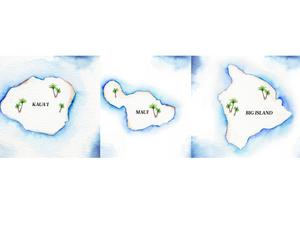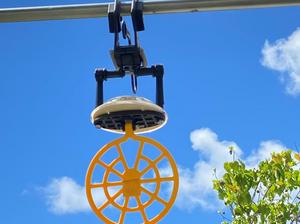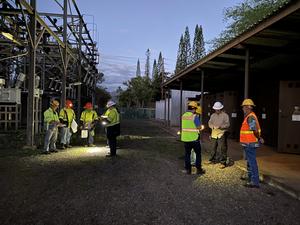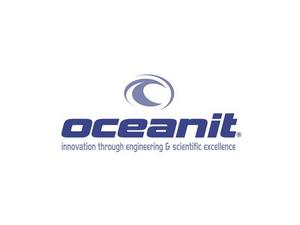Even during a severe storm, a power provider is expected to keep its operations intact and repair damage in a timely fashion.
The coronavirus pandemic was a squall of disruption like no other for Hawaii, bringing to a screeching halt to tourism and all its dependent industries. Yet Hawaii’s long-term energy goal to achieve a 100% renewable portfolio standard by 2045 was still there and short-term problems, like integrating renewables projects onto the grid in a timely fashion, remained.
The five participants in Pacific Business News’ 2021 Energy Roundtable largely struck an optimistic tone on the Islands’ present and future over the course of a two-hour virtual discussion on June 25 — while acknowledging there is still no silver bullet to reach the final destination.
Distributed energy and storage, electric vehicle infrastructure, utilities’ role, land use and social equity, supply chains and future tech were prominent points of conversation.
The panelists were: Jim Alberts, senior vice president of operations, Hawaiian Electric Co.; Brian Kealoha, executive director of Hawaii Energy; Ramsay Siegal, managing director of impact, Elemental Excelerator; Josh Powell, CEO of RevoluSun; and Jeff Mikulina, executive director of Blue Planet Foundation.
Kealoha, whose ratepayer-funded group specializes in energy efficiency programs for residents and businesses, capped off the panel by describing what he feels is a broader appeal for energy transformation in political, private and public spheres.
“Our industry isn’t always sexy, but we’re getting to be sexier and sexier, I feel like, every day,” Kealoha said.
The Panelists
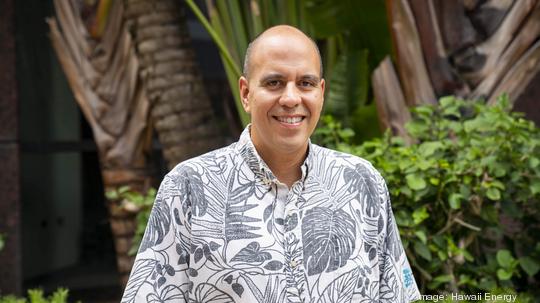

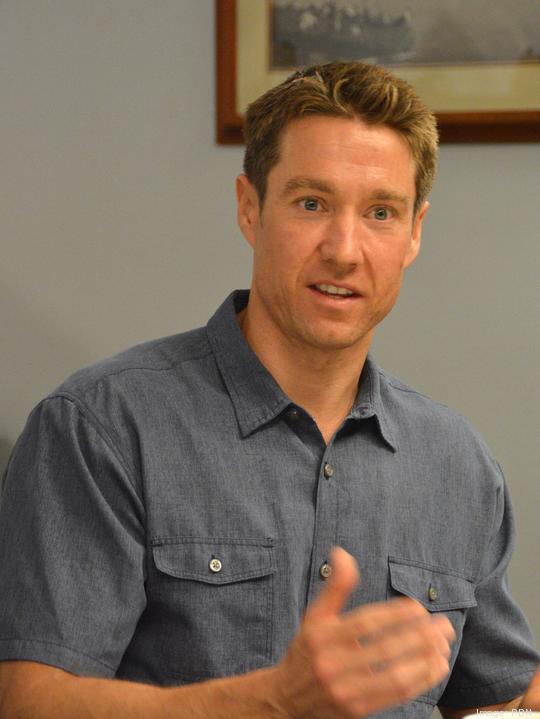
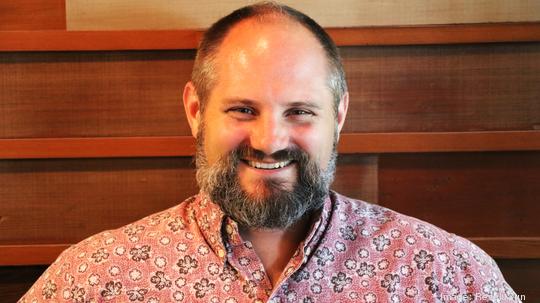

Pandemic Tailwind
A parallel emerged between the pandemic and the mounting threat of climate change, Mikulina observed.
“Big problems come in small packages, with a tiny virus and tiny carbon dioxide molecules,” he said.
That underlying realization may have had the effect of galvanizing people to address climate issues over the last 16 months that were previously on the back-burner, or discover a passion for creating change that was not there before.
Powell, the leader of the state’s biggest residential photovoltaic panel provider, noted that carbon has been tracked for 50 or 60 years, but hasn’t seen the level of attention paid to it until now.
“It created a lot of urgency. It sort of made us think, hey, this stuff’s real,” Powell said.
Elemental Excelerator, an incubator for clean-tech startup companies, expected to see a decline in participation during its latest cohort.
Instead, some 1,400 people applied to be interns for 30 positions in Elemental’s portfolio companies.
Siegal compared it to pushing a boulder up a hill and reaching a peak somewhat unexpectedly.
“We had just as many companies interested in our funding and support, really strong technologies,” Siegal said. “It feels like there’s a tailwind for climate work. I don’t know if it’s because of the pandemic, or maybe the stars aligning for different reasons. But we’re just seeing so much interest.”
There will be lasting change as a result of the pandemic, Alberts believes.
“We’ve talked about distributed resources, but now we’ve got distributed people,” he said. “I think that’s going to last a long time where many businesses are going to allow their workforces to work from home.”
For example, that shifts where and how HECO would look to deploy make-ready EV charging infrastructure, while keeping equity in mind — Alberts, who is on the board at Aloha United Way, noted over half of Hawaii’s families qualify as ALICE, or Asset Limited, Income Constrained, Employed.
Kealoha was pleasantly surprised by the rate at which people, both residentially and commercially, took advantage of rebate programs during the pandemic.
“Those businesses that had the financial wherewithal that really saw this as a pause, knew that they were going to come out fine on the other side, they actually used the time to invest in energy efficiency,” he said.
But now, as businesses are trying to re-launch and people get back to their pre-pandemic lives, energy efficiency hasn’t been as much at the forefront.
“We’re starting to see a little bit of a valley, and we’re watching that to see how we can best address the needs of our residential and commercial clients,” Kealoha said.
Blue Planet Foundation used the pandemic to craft a 50-point series of potential climate and energy actions the state could take to emerge better on the other side, called waypoints.
“We could use this moment, this pause, to really rethink and reimagine some underlying parts of our economy,” Mikulina said. “Things are bouncing back pretty rapidly.”
He was pleased to see some of the waypoints addressed during the recent legislative session. Specifically, Gov. David Ige signed three bills to further the use of EVs in the Islands’ public and private sectors.
Where are we now?
Hawaii achieved its required benchmark of 30% statewide renewables in 2020, with HECO posting 35% and the Kauai Island Utility Cooperative running at about two-thirds.
HECO is a nexus for much of the progress, as it has 16 renewables projects from developers worth some $4 billion set to come online in the coming years.
The utility that oversees electricity on Oahu, Maui County and Hawaii Island officially started its new method of revenue generation, performance-based regulation, on June 1 — although it had prepared for the switch from traditional cost-of-service regulation for years after considerable negotiations with the Hawaii Public Utilities Commission.
Performance incentive mechanisms like incorporation of green energy and effective customer service are now the ways it makes money, as opposed to selling more energy to ratepayers.
Alberts called the build-up to PBR, as it’s known, the “most collaborative process in the regulatory environment we’ve ever seen.”
He said it’s off to a great start.
“It creates the right incentive mechanisms for us to create alignment. It recognizes that the utility itself has to remain strong in order to provide support for all these other activities that need to happen.”
Getting renewables projects to come online in a timely fashion remains one of the biggest challenges of the day — hence the creation of the Powering Past Coal Task Force that Ige created in March to bring stakeholders together.
As it stands, the 180-megawatt AES coal plant at Barbers Point on Oahu will come offline in September of 2022 and a new large battery, Plus Power’s Kapolei Energy Storage project slated for completion next summer, will bridge the gap to solar-plus-storage projects coming online in the ensuing months. But KES will likely require expensive oil-firing in the interim.
Powell said the biggest energy problem in Honolulu is the permitting process when it comes to commercial-scale projects, specifically in the 500-kilowatt to 1-megawatt range, though he credited HECO for cutting through much of the red tape for residential solar in recent months.
“[Large-scale projects’ processes] can still be fairly time-consuming and complicated and I would argue that most of them, they’re not very challenging and we have the technical expertise to solve those things,” Powell said.
Residential PV permitting numbers have climbed steadily over the last few years. Through the first five months of 2021, new PV systems on Oahu included a battery storage component 83.3% of the time, an all-time high.
“All these batteries are integrated in a way they can be utilized on the grid and for resilience,” Powell said. He estimated that there’s between 25 and 30 megawatts of distributed PV power on Oahu’s grid.
The global storage supply chain has been strained with increased demand for battery materials like lithium and cobalt; some PV providers and their customers have seen wait times of weeks or months for new systems with storage. Powell believes that will be a short-term concern that will yield a system in which materials can be recycled and improved with each battery life cycle iteration.
Kealoha noted that the state is on track to exceed its Hawaii Energy Efficiency Portfolio Standard target for 2030. Hawaii’s goal by then is to reduce electricity consumption by 4,300 gigawatt-hours.
“For us to get to that 100% [RPS], we need to reduce that energy consumption,” Kealoha said. “Especially on Oahu, we’re going to have a hard time building our way there without finding ways to have more flexible demand response, energy efficiency and conservation.”
Mikulina, whose group regularly measures Hawaii’s progress in various sectors on its journey to carbon neutrality, said the state should be proud of its gains in electrification.
Transportation, however, is lagging, with about 20 metric tons of carbon produced by Hawaii every year. In 2019, on its most recent Blue Planet “report card,” the state received a D in that sector.
“We have the best resources to tap into to drive our prices down for electricity, and that’s exciting,” Mikulina said. “It didn’t always used to be this way; we had to make hard tradeoffs. … We are going to make tradeoffs going forward. There’s issues that are converging about siting, about equity. So we have to make sure we go together on this journey to 100%.”
Siegal said the opportunity for job creation, putting people back to work, and diversifying the economy is paramount.
“We’re ahead of schedule. We work internationally with technology companies that are early in their journey,” she said. “Many want to prove themselves in Hawaii and see Hawaii as a frontrunner and a place that’s really leading the way and creating moments of inspiration for other places in the world.”
What’s next?
The question as to whether Hawaii can get to a 100% RPS in the years to come based on current technology sparked some interesting dialogue.
HECO has plans to phase out its fossil fuel plants in the years ahead. But diversity in power sources is still a necessity for a place as isolated as Hawaii, Alberts believes, and thus allowances should be made for future technologies to emerge and not be crowded out.
“I think some of the new technology still has to come yet,” he said. “The exciting part for me is there’s so much money and innovation in this space that’s happening, there’s going to be things created that we don’t even know about yet, to help solve this problem long-term.”
Kealoha countered that he’d be concerned that a narrative that the state doesn’t have the requisite energy tech would naturally cause people to hesitate in embracing EVs and EV infrastructure, waiting instead for the next generation of technology.
“The reality is we have the technology to get us much further down the pathway,” Kealoha said. “It isn’t like we’re sitting at 80% [renewables] right now and we’re saying ‘this last 20% is hard, we’ve run out of land, we’ve run out of new technology.’ There’s a lot that can be done.”
Discussions of land use for utility-scale projects, versus agriculture or housing, have the potential to intensify between stakeholders and communities. Siegal pointed out that hybrid agriculture and solar farm projects have begun to emerge.
She said the key for more widespread adoption of energy solutions for private entities is to sell it to executives from a technology perspective, not a climate perspective. Meanwhile, the state should keep moving with what it has, given the low cost of wind and solar compared to other generation technologies, she said.
“We can’t sit around waiting for a technology breakthrough that’s going to be an alley-oop and save the day,” Siegal said. “We have everything we need. It’s just a matter of creatively packaging it, selling it, structuring the deal so that it’s irresistible to everyone.”
Something on the immediate horizon is a distributed “virtual power plant” on HECO’s grid for about 6,000 residential PV users who agree to partner with California-based Swell Energy and the utility to make their batteries available to provide power to the rest of the grid.
“There’s been times where it’s felt like [solar companies and utilities] have been in rigid opposition, and I really see a pretty exciting future,” Powell said. “I think Hawaii and Oahu in particular has an opportunity to lead in some of the most exciting technology out there.”
Hydrogen power, still an elusive energy solution to produce on a wide scale, has begun making inroads into the general consciousness.
Mikulina is curious to see if that can be successfully incorporated in aviation, which accounts for much of Hawaii’s share of carbon pollution.
“I think it was Bill Gates who said we tend to overestimate the change in the next year and underestimate the change in the next 10 years. Totally accurate with Hawaii,” Mikulina said.
“The things we do have, the learning curves continue to get better too, on storage, on integration, photovoltaic, wind, offshore wind. So I’m sure we’ll be seeing some amazing things in the next 10 years — maybe not in the next year.”
